Physical Address
304 North Cardinal St.
Dorchester Center, MA 02124
Hippocrates provided the first description of what is now called craniosynostosis in 100 BC and noted the variation of skull deformities and correlated it with the pattern of cranial suture involvement. There are many historical descriptions of people with unusual head shapes. The Greek statesman and General Pericles had an unusually long, narrow head shape and was nicknamed “Squill head,” and he might have had sagittal synostosis. Aristophanes and Galen both used the term oxycephalus for “tower head.” The term craniosynostosis was first used by Otto in 1830 to describe the entity of premature suture fusion. Virchow described how in medieval Saxony, people believed that such children were thought to be changelings or monsters and that it was the devil who made them deaf, dumb, and blind. Virchow examined skulls from various museums and published a classification where he correlated synostosis of specific cranial sutures with head shape. What has become known as Virchow’s law is that premature fusion of a cranial vault suture (craniosynostosis) inhibits skull growth perpendicular to the fused suture and compensatory overexpansion takes place at patent sutures. The general direction of growth after synostosis is parallel to the fused suture. For example, when synostosis of the sagittal suture occurs, growth proceeds in an anteroposterior direction, leading to scaphocephaly and a long, narrow, boat-shaped skull ( Fig. 20.1 ).
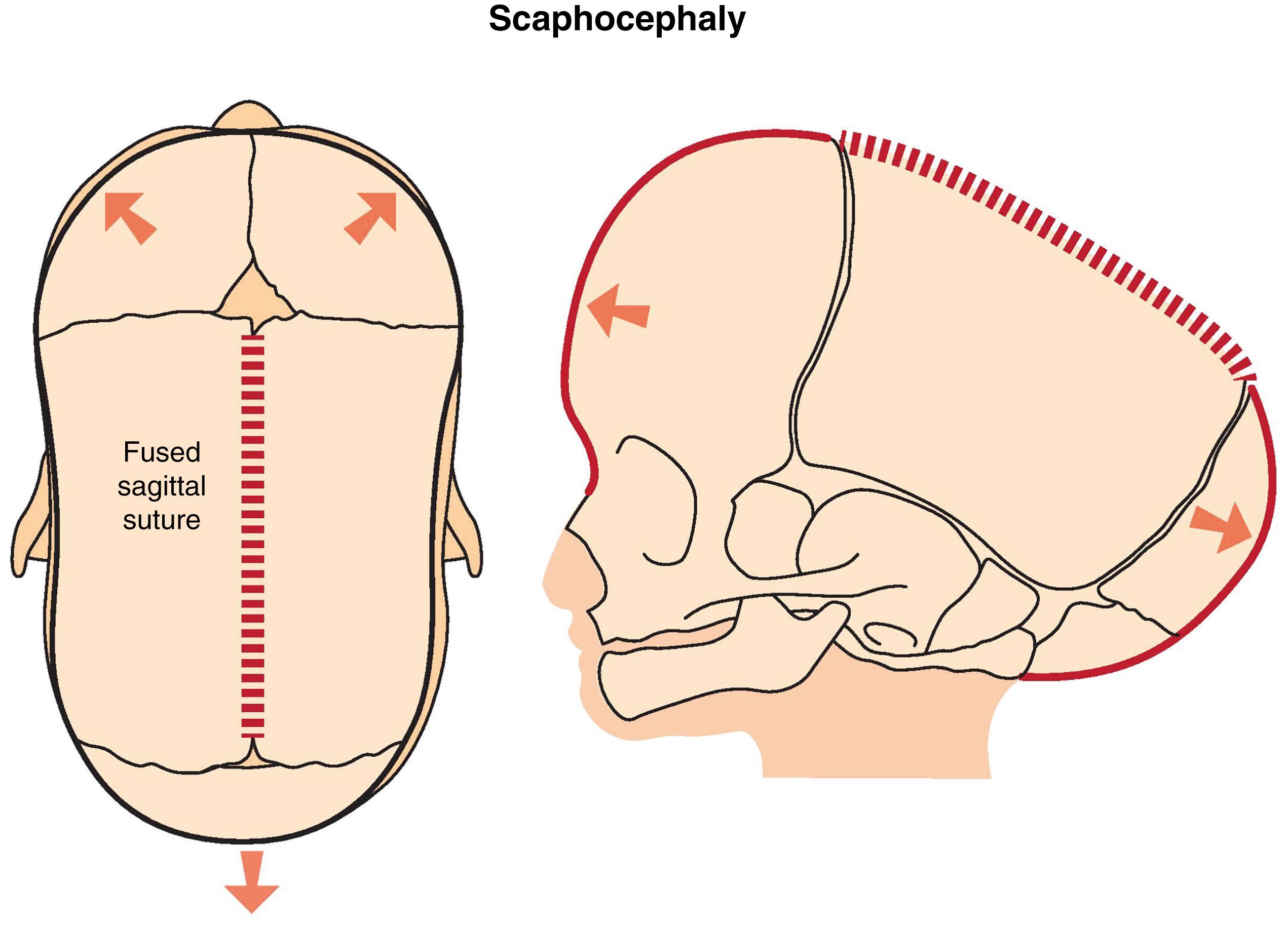
The developing skull is divided into the neurocranium, which surrounds the brain, and the viscerocranium, which develops into the facial bones. The neurocranium is made up of bones that ossify directly, the membranous neurocranium, which forms the skull vault, and bones that undergo endochondral ossification and form the skull base. The flat bones of the skull grow by the deposition of new bone material at their margins. In their growth phase, these bones do not fuse but remain separated by specialized structures, the cranial sutures. Skull growth is needed to accommodate the size of the growing brain and depends on an exchange of signals between mesenchyme, the osteogenic front, and the dura mater.
Normal growth of the calvarium is complete at about age 2 years, the orbit at age 6 years, and the rest of the facial skeleton at about age 16–17 years. Brain growth drives the enlargement of the skull in infancy. The expanding brain doubles in size in the first 6 months of life and then doubles again in the second 6 months and doubles again between 12 and 24 months. The expanding brain creates separating tensional forces in the cranial sutures. The cranial sutures allow for skull deformation during birth and expansion during brain growth. The metopic suture normally starts to close at the age of 2 years. The sagittal suture begins to close after the age of 22 years, the coronal suture after 24 years, and the lambdoid after 26 years. It is within the normal range for them not to fully close until the age of 40 years.
The prevalence of craniosynostosis ranges from 3.1 to 7.2 in 10,000 live births. Fusion can occur in one or in multiple sutures and in 21% of the cases fusion is caused by a known gene mutation. , . In nonsyndromic craniosynostosis one suture is fused without additional birth deficits and can affect any cranial suture. Sagittal synostosis is the commonest, with a prevalence of 40%–60%. Overall, the incidence of craniosynostosis has increased, but especially a rise of metopic synostosis has been reported (25% of nonsyndromic craniosynostosis), currently the second most common type, followed by unicoronal synostosis (<15%) – an unexplained change that occurred in Europe and the United States. , The rarest type is lambdoid synostosis (1% of all craniosynostosis and 3% of nonsyndromic craniosynostosis). Craniosynostosis usually occurs as an isolated condition, but has been reported to be associated with more than 200 syndromes. In syndromic craniosynostosis one or multiple sutures are fused with the presence of other congenital anomalies. Associated phenotypical features can include calvarial and facial hypoplasia and dysmorphology, hydrocephalus, deafness, blindness, mental retardation, and extremity anomalies. Craniosynostosis can have functional consequences.
Nonsyndromic: sagittal, metopic, coronal, multisuture, lambdoid, frontosphenoidal
Syndromic: e.g., Muenke, Crouzon, Pfeiffer, Apert, Saethre–Chotzen.
Metabolic disorder (e.g., hyperthyroidism, hypercalcemia, hypophosphatasia, sickle cell disease and thalassemia, vitamin D deficiency, renal osteodystrophy)
Malformations (e.g., holoprosencephaly, microcephaly, shunted hydrocephalus, encephalocele)
Exposure of fetus to teratogenic drugs (e.g., sodium valproate, phenytoin, retinoic acid)
Mucopolysaccharidosis (e.g., Hurler syndrome, Morquio syndrome).
Nonsyndromic craniosynostoses, capturing 60% of all craniosynostosis, are mainly sporadic, however due to advances in genetic diagnostics, nonsyndromic single suture patients are increasingly recognized as syndromic patients. An example of this is the discovery of the FGFR3 P250R mutation in patients with (bi)coronal synostosis resulting in Muenke syndrome. Moreover, an increasing incidence among first-degree relatives (2%–10% of the patients) is seen, mostly in patients with metopic synostosis followed by multi-, sagittal, lambdoid and coronal suture. Sagittal synostosis is thought to be the most isolated. Multisuture synostosis without known genetic cause has the highest frequency of associated symptoms, such as ear infections, palatal abnormalities, and hearing problems.
The genetic causes of nonsyndromic craniosynostosis remain largely unknown. Mutations in the genes causing syndromic craniosynostosis and chromosomal abnormalities are not a common cause of nonsyndromic craniosynostosis. Nonsyndromic craniosynostosis as a ‘developmental pathway disorder’ has been suggested. On the latter, a stronger influence of genetic factors in the etiopathogenesis of nonsyndromic craniosynostosis has been implied. The SMAD6 mutation was found in 7% of patients with midline (sagittal and/or metopic) nonsyndromic craniosynostosis and in 25% of the patients with familial occurrence of midline craniosynostosis. Moreover, mutations such as ALX4 , BBS9 , BMP2 , EFNA4 , IGF1R , RUNX2 , SMURF1 , SPRY1 , SPRY4 are thought to be responsible for the fusion of a specific single suture.
The best understood skull developmental cascades include bone morphogenetic proteins (BMP)/transforming growth factor beta (TGFβ), fibroblast growth factor (FGF), hedgehog (HH), eph-ephrin and wingless-type MMTV integration site family (WNT) signaling pathways. Most of these pathways are known to play a role in neural crest development, hence driving the morphogenesis of the craniofacial complex. There is good evidence that the primary pathology in craniosynostosis is within the dura mater and not within the bone. Cranial suture fusion and maintenance of patency are dependent on the interplay of transcription factors, cytokines, growth factor receptors, and extracellular matrix molecules.
The majority of craniosynostosis syndromes are caused by mutations in genes encoding FGFR-1, FGFR-2, and FGFR-3, and the transcription factors TWIST1 (upstream regulator of FGFRs), MSX2, and ALX4. Gain-of-function mutations are associated with the human genes MSX2 , ALX4 and FGFR , whereas loss of function is associated with the TWIST1 gene EFNB1 . In 2016, SIX2 was found in patients with syndromic complex or sagittal synostosis. ZIC1 is among the latest identified craniosynostosis-associated genes. New mutations are expected to be found in the future, on account of which the number of syndromic craniosynostoses will increase. After the discovery of P250R FGFR3 mutation, Muenke syndrome is the most frequent syndromic craniosynostosis, followed by Crouzon syndrome and Pfeiffer syndrome. Apert syndrome ( FGFR2 ) has the lowest frequency. A complete list of genetic causes of craniosynostosis can be found in the OMIM database.
Syndromic craniosynostoses exhibit variable clinical and genetic heterogeneity. Crouzon and Pfeiffer both have their mutation on FGFR2 . These syndromes can occur clinically identical regarding facial features, but in Pfeiffer also broad and short big toes and thumbs are seen. This distinction can be difficult and even irrelevant.
Targeted FGFR1 , FGFR2 , FGFR3 , and TWIST1 genetic testing is appropriate as a first-line test for patients with coronal, complex nonsyndromic, and syndromic craniosynostosis. Mutation analyses of TCF12 and ERF are justified in all patients with coronal synostosis who are negative for FGFR and TWIST1 mutations. The value of these tests for patients with sagittal and lambdoid CS is minimal, if any.
F GFR3 Pro250Arg mutation
Autosomal dominant or de novo
Birth prevalence 1:30,000, 8% of the craniosynostosis cases.
Brachycephaly due to fused (bi)coronal ± other sutures
Various minor anomalies
Mild midface hypoplasia, downslanting palpebral fissures, mild ptosis, high arched palate, strabismus.
Minor anomalies of hands and feet, e.g., brachydactyly, clinodactyly, can occur. Almost all patients have hearing loss. Typically, females are affected more severely. In general, Muenke patients have a normal intellect, although developmental delay occurs in approximately one-third ( Fig. 20.2 ).
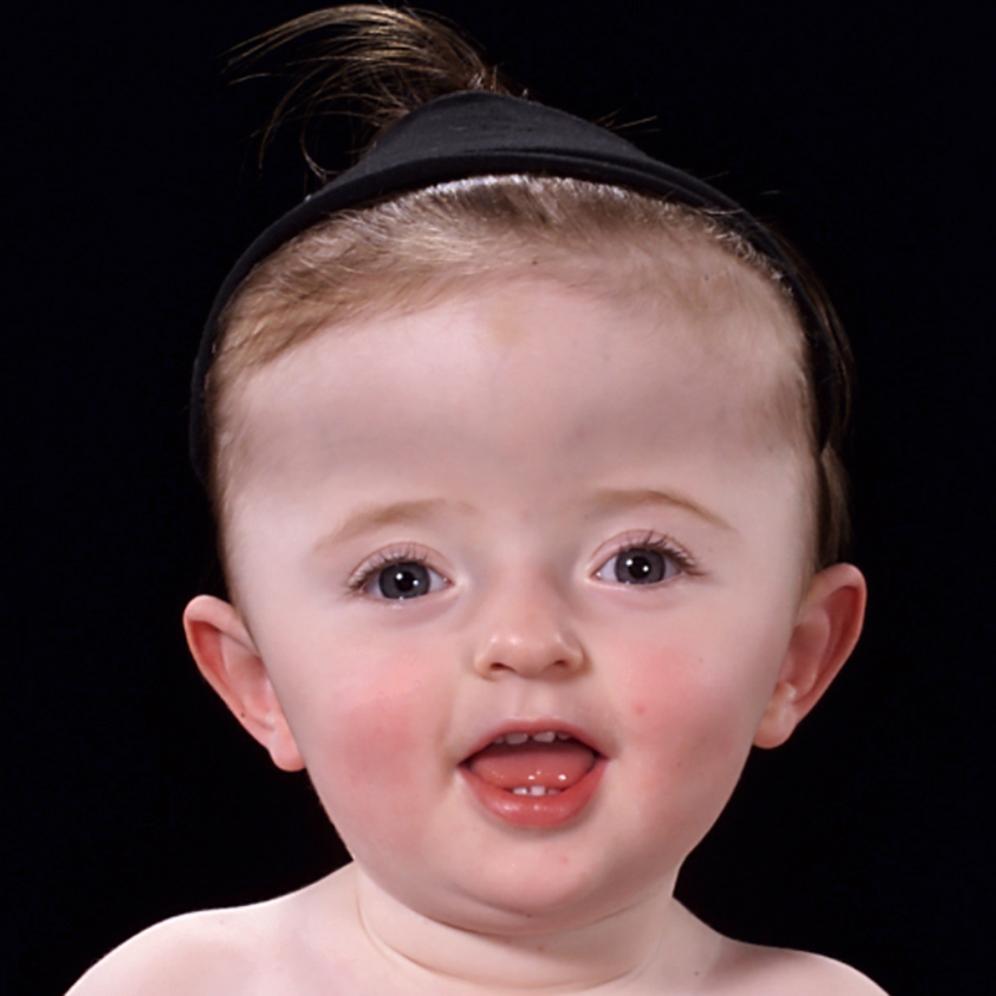
FGFR2 mutations
FGFR3 mutations Crouzon with acanthosis
Autosomal dominant or de novo (increased risk with older paternal age)
16.5 per million births, 4.8% of the craniosynostosis cases.
Brachycephaly due to fusion of bicoronal ± sagittal and lambdoid sutures (can be absent or delayed)
Maxillary hypoplasia
Hypertelorism due to short, wide anterior cranial base
Exophthalmus with retruded supraorbital, infraorbital, and lateral orbital rims
Orbital dystopia and strabismus can occur
20% develop optic atrophy
Class III malocclusion.
Up to 30% present with hydrocephalus. Some have a reduced nasopharynx, which can contribute to obstructive sleep apnea (OSA). Also raised intracranial pressure (ICP) and hearing loss can be observed ( Fig. 20.3 ).
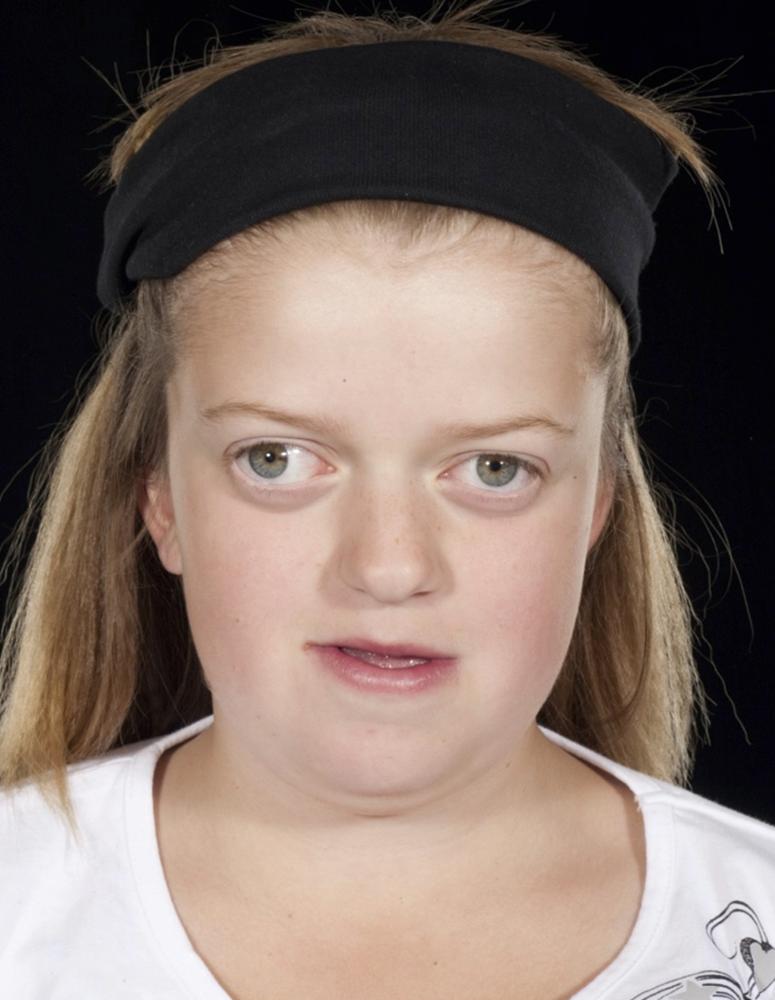
FGFR1 mutation (8p11.2-p11)
FGFR2 mutation (10q26.13)
Autosomal dominant or de novo (increased risk with older paternal age)
1 in 100,000 individuals.
Brachycephaly due to fused bicoronal sutures
Maxillary hypoplasia
Broad radially deviated thumbs and big toes
Exorbitism due to shallow orbits.
Partial syndactyly of fingers and toes is seen; additional anomalies can include ankylosis of the elbow and other joints, congenital airway malformations, deafness and neurodevelopmental abnormalities ( Fig. 20.4 ).
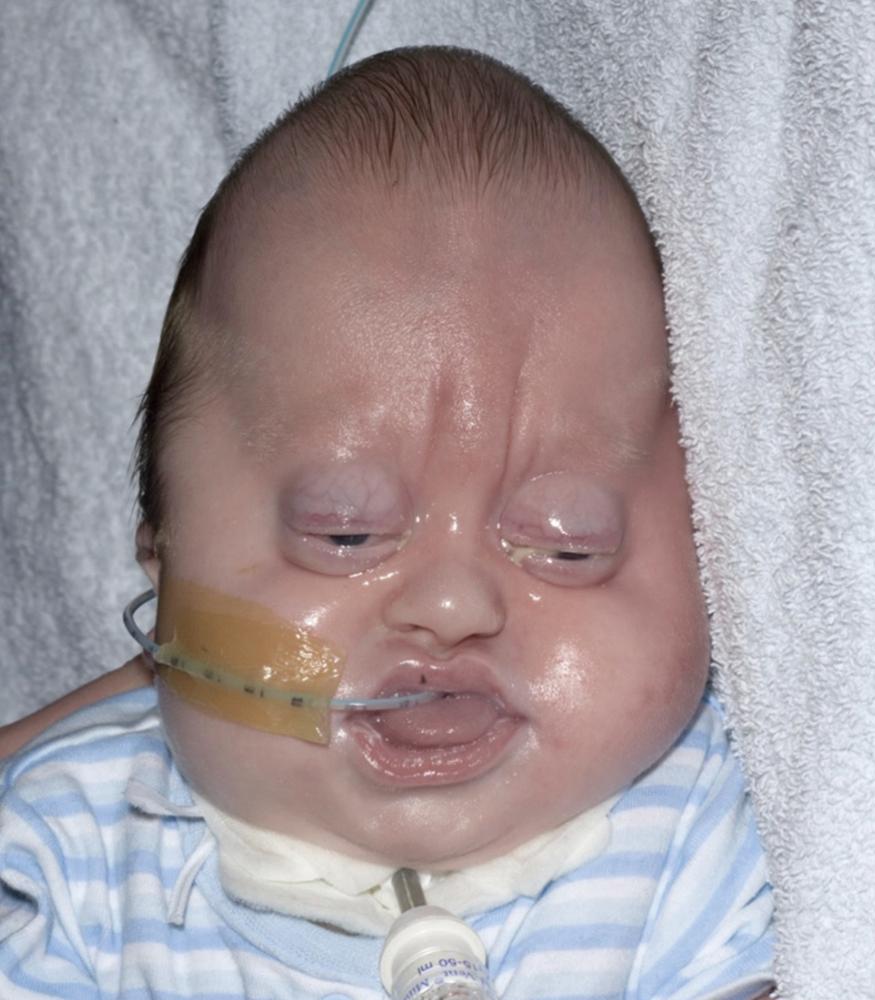
FGFR2 (10q26.13) mutations
Amino acids Ser252Trp and Pro253Arg
Deletion exon IIIc
Alu insertion exon IIIc
Autosomal dominant or de novo (increased risk with older paternal age)
Birth prevalence 15.5 per 1 million births, 4.5% of craniosynostosis cases.
Turribrachycephaly due to fused bicoronal sutures
Hypertelorism
Exorbitism due to shallow orbits
Downslanting palpebral fissures
Complex syndactyly of the hands and feet (Upton classification, see Table 20.1 )
| Deformity | Type I | Type II “Mitten Hand” | Type III “Hoof Hand” |
|---|---|---|---|
| Thumb radial clinodactyly | Present | Present | Present |
| Index radial clinodactyly | Absent | Present | Present |
| First web syndactyly | Simple (nonosseous) | Simple (nonosseous) | Complex (osseous) |
| Complex 2–3–4 syndactyly and symbrachyphalangism | Present | Present | Present |
| 4–5 syndactyly | Simple, incomplete | Simple, incomplete | Simple, complete |
Maxillary hypoplasia
Wide-open calvarial defect from the root of the nose to the posterior fontanelle in the midsagittal plane
Class III malocclusion, anterior open bite and dental crowding
Cleft palate with high arched palate can occur.
Additional anomalies can include fusion and malformation of other joints, e.g., the elbows and shoulders, cervical vertebral fusions, congenital airway malformations, deafness, and neurodevelopmental abnormalities. Also, globe subluxation can occur. The quality of the skin frequently varies from normal, to dermal problems such as acne and hyperhidrosis ( Fig. 20.5 ).
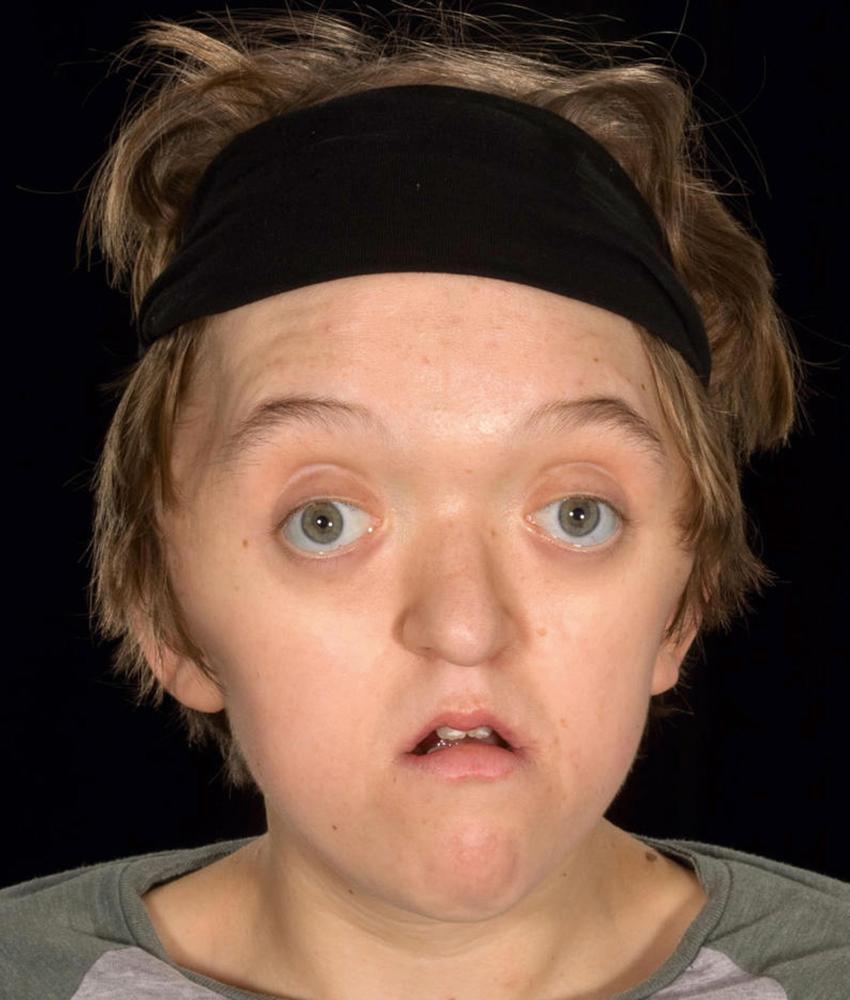
Become a Clinical Tree membership for Full access and enjoy Unlimited articles
If you are a member. Log in here